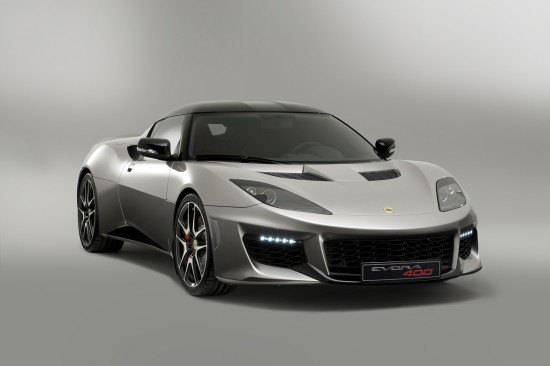Geneva 2015: Lotus Evora 400 Arrives
Coming this fall to the U.S., the Lotus Evora 400 made its official debut at the 2015 Geneva Auto Show.
The Evora 400 gets its name from the horsepower generated by its supercharged 3.5-liter V6, which also throws down 302 lb-ft of torque out of the back through a six-speed manual or auto. The figures are 55 horses and 7 lb-ft over the previous Evora thanks to a new supercharger and water-to-air intercooler, and a revised engine management system.
Zero to 60 is achieved in 4.1 seconds, with speed topping out at 186 mph. Braking is improved as well, while 19- and 20-inch wheels shod in Michelin Pilot Super Sports maintain contact with the road. The Evora 400 is also 1.4 inches longer than the original — coming in at 173 inches now — and weighs 49 lbs. less.
Europeans will get theirs this summer, while those in the U.S. will be able to take one home as a 2016 model in the fall. No price of admission was announced at this time.
Seattle-based writer, blogger, and photographer for many a publication. Born in Louisville. Raised in Kansas. Where I lay my head is home.
More by Cameron Aubernon
Latest Car Reviews
Read moreLatest Product Reviews
Read moreRecent Comments
- SCE to AUX Range only matters if you need more of it - just like towing capacity in trucks.I have a short-range EV and still manage to put 1000 miles/month on it, because the car is perfectly suited to my use case.There is no such thing as one-size-fits all with vehicles.
- Doug brockman There will be many many people living in apartments without dedicated charging facilities in future who will need personal vehicles to get to work and school and for whom mass transit will be an annoying inconvenience
- Jeff Self driving cars are not ready for prime time.
- Lichtronamo Watch as the non-us based automakers shift more production to Mexico in the future.
- 28-Cars-Later " Electrek recently dug around in Tesla’s online parts catalog and found that the windshield costs a whopping $1,900 to replace.To be fair, that’s around what a Mercedes S-Class or Rivian windshield costs, but the Tesla’s glass is unique because of its shape. It’s also worth noting that most insurance plans have glass replacement options that can make the repair a low- or zero-cost issue. "Now I understand why my insurance is so high despite no claims for years and about 7,500 annual miles between three cars.










































Comments
Join the conversation
Has anyone else notice the distinctly different roll out of the Porsche GT4 and the Evora 400? Porsche announced the car with pricing, there were reviews of the car available and the car is sold out most markets. The Lotus? There is a range of pricing, no set prices in England and no pricing in the U.S. Reviews? None, just the claim that the car is 6 seconds faster around their track. Put it all together and my guess is that Porsce announced a finished product at Geneva. The Lotus was still in final development at the time it was announced and Lotus is scrambling to get everything done in time to start shipping in August. Would not be surprised to see further delays.
Been reading comments on the pricing for the Evora. Most make comparisons to the GT4 which I think is mostly due to both cars being introduced at the same time. It is also completely wrong. 1) the Lotus will not compete with the GT4 because that car will be sold out in most markets long before the Evora is on sale 2). The Evora is a 2 plus 2 and the Cayman is a 2 seater. This car is aimed and priced to be competitive with the 911. I seriously doubt Lotus priced the car in competition with the GT4. The Evora would have to be priced under the GT4 to be competitive 3). The GT4 is a track focused car. The Evora is Lotus' version of a GT car. The car have different foci. None of this means that Lotus will have an easier time competing with the 911, but it is at least priced well under that car. The concerns about build quality, reliability and limited dealer network remain. The 911 is certainly the safer choice